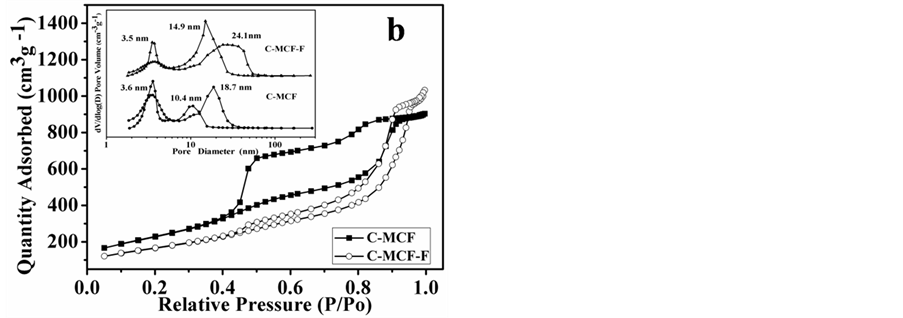1. 引言
自由酶由于其操作稳定性低,且不便于回收再利用,在很多领域上的工业化应用都受到了限制。而之前的研究表明,将酶通过各种途径束缚于适当的空间内,可以在很大程度上保留酶的催化特性并减少酶的变性;同时在独立的空间,也有效避免了酶与酶之间或者酶与化学催化剂之间的交互作用[1] 。因此,将酶或者其他蛋白质分子通过物理或化学的方法束缚于不溶于水的无机材料载体是酶应用的主要途径[2] -[3],而介孔材料由于其孔径尺寸与酶的尺寸相匹配而成为酶固定化载体的研究热点[4] 。
根据国际纯粹与应用化学联合会(IUPAC)的分类,介孔s材料为孔径分布集中在2~50 nm之间一类材料。其中介孔碳泡沫分子筛(C-MCF)具有类似于二氧化硅介孔泡沫分子筛(MCFs)的蜂窝状介孔泡沫结构,由很多通过均一窗口连通的球形孔室构成[5] ,具有较大的比表面积和孔容、可调的超大介孔孔径和胞体孔径(10~50 nm),对于诸如葡萄糖氧化酶(Glucose oxidase, GOD)等大分子尺寸蛋白质(7.0 nm × 5.5 nm × 8.0 nm[3] )的吸附具有显著优势。此外,碳材料的导电性也使其应用扩展到电极材料、电化学生物传感器、酶燃料电池的催化剂载体材料等方面。
目前,关于酶的吸附载体的研究多为硅基介孔材料,碳基介孔材料研究较少,但碳基材料负载生物酶在载体材料自身结构稳定性及保持生物酶活性等方面表现出明显的优势[6] 。此外,酶的吸附量在很大程度上依赖于载体材料的孔径及孔容的大小[7] ,但关于C-MCF的孔径及窗口直径对葡萄糖氧化酶的吸附性能的影响却鲜有报道。因此,本文在分子筛合成过程中通过添加氟离子改性制备不同孔径结构的MCFs并以其为硬模板制备不同孔径结构的C-MCF,借助SEM、TEM和氮气吸附等测试手段进行表征。以C-MCF为葡萄糖氧化酶的载体材料,在pH = 5.0(葡萄糖氧化酶的等电点[9] )的Na2CO3-NaHCO3缓冲溶液中研究了不同胞体和窗口孔径及其颗粒大小的MCFs和C-MCF对葡萄糖氧化酶吸附行为的影响。
2. 实验
2.1. 原料与试剂
三嵌段共聚物聚氧乙烯–聚氧丙烯–聚氧乙烯(Pluronic P123,MW = 5800, EO20PO70EO20),葡萄糖氧化酶(EC 1.1.3.4)购自美国Sigma公司。正硅酸乙酯(TEOS),1,3,5-三甲苯(TMB),氟化铵(NH4F),糠醇(FA),氢氧化钠(NaOH)均购自成都市科龙化工试剂厂。试验所有用水为二次去离子水。
2.2. MCFs介孔泡沫分子筛的制备
MCFs介孔分子筛的合成方法为微乳液模板法[10] ,具体制备过程为:将2.0 g Pluronic P123溶于60 ml 2.3 mol/L的HCl溶液中;待其充分溶解后,向溶液中缓慢滴加2.0 g TMB,升温至37℃并强力搅拌1 h后,加入4.4 g TEOS,剧烈搅拌5 min后保持温度于37℃静置20 h。紧接着将溶液转入带有聚四氟乙烯的水热晶化釜中,于100℃的烘箱中处理24 h。待溶液冷却至室温后过滤得白色固体,在50℃的真空干燥,所得样品在550℃的马弗炉中保温6 h后自然冷却至室温得到白色粉末即为MCFs。如果在溶液中加入TMB之前加入0.023 g NH4F,则合成了氟离子改性的MCFs(样品记为MCF-F)。
2.3. C-MCF介孔碳泡沫分子筛的制备
C-MCF的制备参考于制备CMK-5的方法[11] ,并做了适当改进。将合成的MCFs粉末采用浸渍法于AlCl3溶液中铝化(Si/Al = 20),铝化后的MCFs(AlMCFs)在介孔内部形成催化位点,这将有利于碳源后期的引入,使其发生聚合反应时均匀的附着于介孔内部表面,最终形成薄碳层。具体合成方法如下:将1.0 g的AlMCFs浸渍于含FA 25%的TMB溶液(8 ml)中搅拌均匀,所得混合溶液置于80℃真空条件下保持12 h,紧接着升温至150℃保持6 h预碳化;所得混合物在氮气保护氛围下以1℃.min−1的速率升温至300℃,再以5℃.min−1的速率升温至850℃后保温4 h;最后用1 M的NaOH溶液除去硅模板得到最终产物,记为C-MCF和C-MCF-F(分别采用MCFs和MCF-F为模板制得)。
2.4. GOD葡萄糖氧化酶的吸附
由于葡萄糖氧化酶的等电点在pH = 5.0附近,此时的葡萄糖氧化酶分子表面几乎不带电荷,酶分子之间排斥力最小,有利于酶分子之间的紧密排列以获得最大吸附量。因此,我们将酶吸附实验的缓冲体系固定选择为pH = 5.0的Na2CO3-NaHCO3缓冲溶液。具体实验过程如下:首先用电子天平称取32.0 mg葡萄糖氧化酶粉末,用16 ml的pH = 5.0的Na2CO3-NaHCO3缓冲溶液将其充分溶解,即可得到浓度为2.0 mg/ml的葡萄糖氧化酶溶液,之后分别称取MCFs、MCF-F、C-MCF和C-MCF-F各8.0 mg于10 ml的离心管中,各加入4 ml缓冲液超声5 min混合均匀。紧接着各取4 ml的葡萄糖氧化酶溶液于上述的四种混合液的离心管中,此时所有的实验样品初始酶浓度为1.0 mg/ml,体积为8 ml。最后将所有实验样品转入恒温水浴摇床中,在温度为25℃,转速为150 r/min的条件下进行吸附。在不同的吸附时间点,取混合液于10000 r/min的离心机上离心10 min后取上层澄清液,用紫外分光光度计测定其280 nm处的吸光度值,以吸附前后的上清液的浓度差来计算葡萄糖氧化酶的浓度。具体计算公式如下:
 (1)
(1)
其中,LGOD为载酶百分比,V0(ml)表示溶液初始总体积,C0(mg/ml)表示上清液的浓度,M(mg)表示载体的质量。
2.5. 材料测试与表征
材料的微观形貌特征由日本HITACHI S4800型扫描电子显微镜测试得出,加速电压为5 kV,硅基样品测试前进行了真空喷金处理。透射结果由美国FEI公司TECNAI G2 F20型透射电镜分析得到,其加速电压为200 kV,测量之前样品分散于酒精中超声振荡10 min,然后滴于铜网上自然干燥。氮气吸附的数据由美国Micromeritic GEMINI VII 2390型物理吸附仪在吸附温度为77 K时测得。其中孔径分布及孔容由Barrett-Joyner-Halenda (BJH)法计算得到。材料的胞体孔径及窗口直径分别由吸附支及脱附支得出。孔容在相对压力(p/p0)为0.99时由氮气吸附量计算得到。比表面积则采用Brunauer-Emmett-Teller (BET)法计算。所有的样品在测量之前均在200℃真空条件下脱气2 h。紫外光谱数据由日本日立公司的U-3010型紫外–可见分光光度计测得。
3. 结果与讨论
3.1. 材料结果表征
图1为两种不同二氧化硅泡沫分子筛和以其为硬模板所制备的两种介孔碳分子筛的SEM和TEM图。SEM观察表明,分子筛呈现出均匀的颗粒分布,未经氟离子改性的分子筛MCFs的粒径大约为1~2 μm(图1a),而氟离子改性过后的分子筛MCF-F粒径明显减小,粒径大约在200~400 nm(图1b);C-MCF和C-MCF-F颗粒分布情况跟各自的模板剂相似(图1c,1d)。根据介孔材料的合成机理,氧化硅泡沫分子筛形成于球形胶束的堆积过程中,在介观结构的形成初期,氟离子的加入会改变胶束中分子之间的电荷平衡和静电作用,最终导致颗粒的减小。从TEM图片可见,四种样品全都呈现出泡沫分子筛典型的3-D蜂窝状介孔泡沫结构,表明以糠醇为碳源,很好的复制出了模板剂的形貌,此外,从图1a和1c大致可以看出MCFs和C-MCF的胞体孔径较小(小于20 nm),而改性后的MCF-F和C-MCF-F胞体孔径增大(大于20 nm)(图1b,1d)。
四种介孔泡沫分子筛的氮气吸附-脱附等温曲线及其孔径分布曲线示于图2。结果表明,所有样品都呈现出典型的langmuir IV型吸附等温线:较低的相对压力下,曲线缓慢向上;较高的相对压力区,等温线迅速上升,表现为介孔材料的典型特征[12] 。而不同的滞后环类型又对应着不同的材料孔结构。从图2来看,样品都显示出H2型滞后环的特征,说明材料具有瓶状口(口小腔大)结构[13] ,从透射电镜可以清晰的观察到材料具有均一的孔室结构,孔室之间靠较窄的窗口相连(分别对应吸附支和脱附支得出的两种不同尺寸的孔径)。从图2a的孔径分布图来看,MCFs相比MCF-F分布较宽,且窗口和胞体孔径都有

Figure 1. TEM and SEM (inset) images of MCFs (a), MCF-F (b), C-MCF (c) and C-MCF-F(d)
图1. MCFs (a),MCF-F (b),C-MCF (c),C-MCF-F (d)的TEM和SEM(内部)图片


Figure 2. N2 adsorption/desorption isotherms and pore size distribution plots (inset) of MCFs, MCF-F (a) and C-MCF, C-MCF-F (b)
图2. MCFs ,MCF-F (a)和C-MCF,C-MCF-F(b)的氮气吸附-脱附等温曲线及其孔径分布曲线(内部)
所增加。可见氟离子的引入扩大了分子筛的窗口孔径和胞体孔径,同时也增加了材料的有序性,这与文献报制了介孔二氧化硅泡沫分子筛的窗口和胞体结构,而其中3.5 nm附近的孔径与去掉硅模板壁后所留道的研究结果一致[14] 。从C-MCF和C-MCF-F的孔径分布(图2b)可以看出,介孔碳泡沫分子筛很好地复的次级孔所对应。此外,制备出的介孔碳泡沫分子筛相较模板在孔径和孔容上都有所减少(表1),而C-MCF-F的吸附支所得出的窗口孔径分布略宽于C-MCF,这可能是在在模板复制过程中由于MCF-F的颗粒较小,引入的碳源容易在表面堆积,不利于进入孔道内均匀覆盖,这也造成了C-MCF-F的窗口孔径略大于其模板剂MCF-F(表1)。
3.2. 葡萄糖氧化酶的吸附
葡萄糖氧化酶在不同载体上的载酶量随时间变化关系曲线如图3所示。可以看出,不同载体对葡萄糖氧化酶的负载差异明显。以模板剂二氧化硅分子筛为载体的吸附量明显整体低于介孔碳泡沫分子筛,且吸附很快达到平衡。
从荷电性能来看,由于MCFs和MCF-F表面的硅羟基与酶分子表面氨基酸残基所带电荷产生静电斥力[15] ,不仅导致最终酶的平衡吸附量(分别为8.15%与15.23%)明显低于表面不带电荷的C-MCF和C-MCF-F的平衡吸附量(分别为32.7%与41.2%),同时它们之间的静电斥力还有可能破坏蛋白质分子的自然形态并导致其结构的改变。而介孔碳泡沫分子筛表面几乎不带电荷,此时缓冲液的pH为5.0刚好又处于葡萄糖氧化酶的等电点附近,既可使材料表面与酶分子之间的静电斥力达到最小而呈现良好的亲和力,同时葡萄糖氧化酶分子间静电斥力也达最小而利于致密堆积。
从负载过程来看,葡萄糖氧化酶的尺寸为7.0 nm × 5.5 nm × 8.0 nm,其中有一个方向的最大尺寸达到了8 nm,而拥有相对大窗口的MCF-F和C-MCF-F对大分子蛋白子的吸附更有利,图3的结果也证实了这一点。虽然C-MCF-F的比表面积小于C-MCF,但其拥有较小颗粒直径(图1d),这有利于酶分子通过孔道扩散进入载体内部,其更大的孔容(见表1)也提供了更大的负载酶的场所,所以C-MCF-F最终葡萄糖氧化酶的负载量最大(41.2%)。与硅基介孔泡沫分子筛比较,虽然两种介孔碳泡沫分子筛的吸附平衡时间相对较长,但在酶分子扩散进入孔道后,由于其较小的载体窗口直径与酶分子大小匹配较好,酶分子将堆积窗口不容易脱落最终束缚于胞体中,这点从图中的C-MCF和C-MCF-F的吸附曲线后期也未表现出下降的趋势可以看出。
上述结果表明,介孔碳泡沫分子筛相对介孔二氧化硅泡沫分子筛在酶的负载上更具优势;同时,载

Table 1. Surface area and pore-structure parameters of samples
表1. 样品的比表面积和孔结构参数表
SBET为BET比表面积;Vp为孔容;Rp(ads)和Rp(des)为样品的窗口孔径和胞体孔径,分别由吸附支和脱附支得到。

Figure 3. Immobilized amounts of glucose oxidase on MCFs, MCF-F, C-MCF and C-MCF-F as a function of time
图3. MCFs、MCF-F、C-MCF和C-MCF-F上溶菌酶的吸附量–时间关系图
体的颗粒大小、窗口直径、孔容以及荷电状态对葡萄糖氧化酶的负载过程和最大负载量等有着非常重要的影响。
4. 结论
本文以经过氟改性的泡沫状介孔分子筛(MCF-F)为模板,糠醇为碳源,制备出了介孔碳泡沫分子筛(C-MCF-F),其颗粒相比以未改性的分子筛为模板制备的介孔碳泡沫分子筛(C-MCF)直径更小,集中在200~400 nm,同时增大了分子筛的窗口直径、胞体直径(分别从10.4 nm和18.7 nm分别增加到了14.9 nm和24.3 nm)和孔容(1.4 cm3 g−1增加到1.6 cm3 g−1),比表面积则有所降低(从835.5 m2 g−1下降到了644.8 m2 g−1)。将所制备的介孔碳材料用于葡萄糖氧化酶的固定,介孔碳泡沫分子筛在酶的负载上比二氧化硅碳泡沫分子筛更占优势,介孔碳与蛋白质间具有更强的亲和力,且结构稳定;另外,拥有更大窗口孔径和更小颗粒分布的C-MCF-F也比C-MCF表现出更优良的固定葡萄糖氧化酶的性能,较大的孔容和适合的窗口表现出了最高的葡萄糖氧化酶的载酶量(41.2%)。因此,C-MCF-F有望成为性能优异的固定酶载体材料,在生物催化,生物传感器和酶燃料电池等领域也将得到广泛应用。

NOTES
*通讯作者。